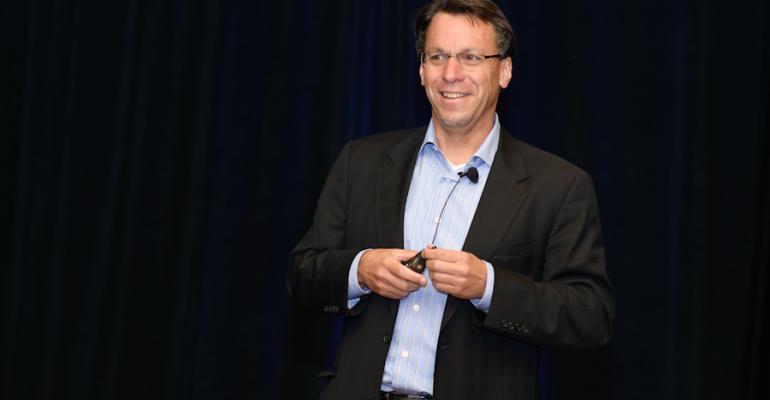With only fleeting mentions of the government shut down and the looming credit default date, Tiburon Managing Principal Chip Roame’s 90-minute presentation to over 200 executives from the financial service’s industry concentrated instead on the state of the U.S. consumer and the changing nature of the wealth management market. Some of the highlights of his presentation include:
The Consumer is Back – At Least the Ones With Money
At first glance, Roame says, consumers are back. They have $34.8 trillion in investable assets, up 40% since 2008. But look closer and the lopsided nature of the recovery is clear; Consumer personal assets are up less than 10% since 2008. The gains in the economy are clearly going to those at the top of the wealth spectrum.
The top 8 percent of U.S. households, those with $500,000 or more, combined hold 77 percent of all U.S. household assets. “Wealth concentration is getting uglier by the day,” said Roame, “It’s bifurcating further. The single biggest long-term economic factor in the U.S. is the vanishing middle class.”
The unemployment rate has fallen from a high of 9.9 percent in 2010 to 7.3% today, Roame pointed out, but less often mentioned is that much of that decline can be attributed to those individuals who have gotten out of the labor force altogether. Today, according to the statistics, 37 percent of the unemployed are considered long-term, meaning out of the labor force for 27 weeks or more, while the overall labor participation rate has actually fallen from 66% in 2008, to 63.2 percent today.
“That’s our economy. And it’s not pretty,” Roame said.
The Perpetually Skeptical Client
Over nine out of ten of the C-suite level executives polled before the conference said consumer confidence in the financial services space would either stay the same or improve in 2014.
Roame disagrees. “I don’t think consumers like financial services and they won’t like it for a long time,” he said, after showing the litany of recent scandals still fresh in investors’ minds, like the Madoff scam, trader Raj Rajaratnam and the SAC Capital affair (“Steve Cohen’s own wife called his business an ‘ongoing racketeering scheme,’” Roame said, reading from the Cohen divorce filings.) Add to that the scandals more recent, like the $11 billion fine of JP Morgan Chase & Co.
“It’s the consistent pattern of offenses that keep investors out of financial services,” he said. And every professional in the industry is tainted by it. “I don’t agree with people who say ‘Oh, I’m a fee-based advisor, I’m a fee-only advisor, I’m different,’” he said. “The consumer doesn’t make any distinction. You’re lumped in with the rest of them.”
One more scandal like the Madoff affair, Roame suggested, would set the industry’s credibility back for a decade at least.
The Illusion of Scale
The market for financial services is so fragmented, said Roame, that any talk of a threat to the smaller player is clearly wrong.
Consider that the biggest money manager is Blackrock, with $3 trillion in assets. Merrill Lynch Wealth Management, among the biggest brokerage firms in the world, has close to $2 trillion in customer assets. That’s a fraction of the $50 trillion households have to invest, he said.
“There is no threat to the small money managers small banks there is no threat to them. It’s a highly fragmented market”
Tactical Stumbles
Thirty percent of Tiburon summit attendees surveyed before the conference suggested tactical asset allocation strategies (where discretionary assets are allocated and re-balanced by asset classes as opposed to using mutual funds,) were the “most impactful” investment trend today, behind “retirement income orientation.”
And in fact, tactical strategies are used by half of financial advisors today, according to Roame’s research. (Eight percent use tactical asset allocation strategies, the other 37 percent use something Roame characterizes as “strategic allocation with a tactical overlay.”) “It’s a nice theory to have all this tactical stuff, but not a lot of evidence it works,” he said. Tactical allocation funds returned 5.5 percent compared to a balanced funds’ average 6.4 percent, according to Roame’s slide, though he neglected to say over what time period.
The Ascendency of Passive Investing
Half of actively managed large-cap funds beat the market, on average. In the best years, only 60% of active large cap funds achieve the same.
Consumers are beginning to notice, suggested Roame. Active equity funds had $125 billion in net in-flows year-to-date, and $192 billion in 2012. Passive funds had $109 billion in in-flows so far this year, but overall investors have pulled nearly $1 trillion out of active management since 2008.
“Has the world shifted to indexing, has the world shifted to passive? Consumers are pushing their money that way,” says Roame.






